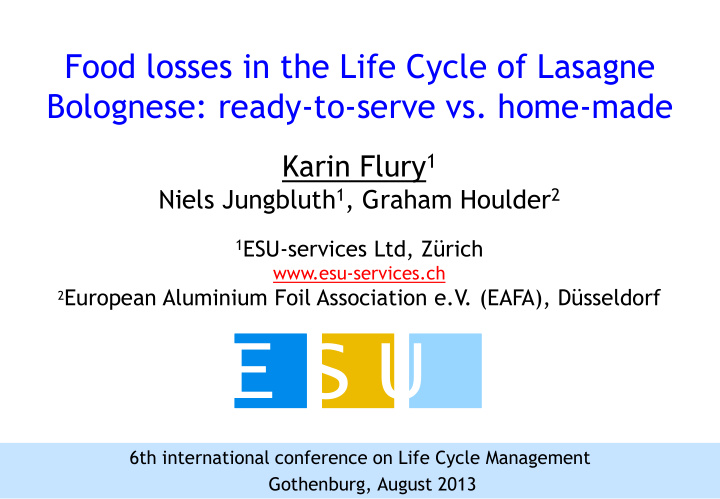



Food losses in the Life Cycle of Lasagne Bolognese: ready-to-serve vs. home-made Karin Flury 1 Niels Jungbluth 1 , Graham Houlder 2 1 ESU-services Ltd, Zürich www.esu-services.ch 2 European Aluminium Foil Association e.V. (EAFA), Düsseldorf E E U U S S 6th international conference on Life Cycle Management Gothenburg, August 2013
Key questions • What is better from an environmental point of view? Ready-made lasagne or home-made lasagne? • How do the following factors influence the performance of both types of lasagne? – amount and type of food waste – energy consumption in production and preparation – efficient preservation vs. fresh ingredients Page 2 www.esu-services.ch
Important system boundaries • Ready-made vs. home-made lasagne • FU: Preparation of two portions (400g) of lasagne Bolognese ready to be heated in oven at home • Same composition for both types of lasagne • Ready-made packed in aluminium container, chilled • Fresh ingredients: seasonal, conventional, regional • Food waste data from Gustavsson et al. (2011), Kranert et al. (2012), Lorrayne (2008) and industry data www.esu-services.ch Page 3
Losses of selected ingredients Ready-made lasagne leads to more food losses for conservable ingredients Page 4 www.esu-services.ch
Food losses Total about the same (24% to 26% losses from farm to oven) Differences in the life cycle stages Page 5 www.esu-services.ch
Greenhouse gas emissions 12 11 kg CO 2 -eq/kg lasagne Preparation 10 ready for heating 9 Storage at household 8 Home transport 7 Distribution and selling 6 Packaging 5 4 Production 3 Ingredients 2 2,5% 1 Food losses 97.50% 0 Ready-made Home-made Losses Total GHG emissions about the same High uncertainties Main differences in distribution, production and preparation Page 6 www.esu-services.ch
Total environmental impacts Ecological Scarcity Method 2006 Total environmental impacts are comparable Ingredients production is most important Page 7 www.esu-services.ch
Summary • No clear ranking of losses or impacts is possible • Ready-made lasagne leads to more food losses for conservable ingredients than home-made lasagne • Differences not based on the food losses but on energy consumption for preparation and storage, packaging etc. • Ingredients are most important • Best case assumption for fresh ingredients greenhouse production or ingredients from abroad worse impacts • Function of both products is slightly different www.esu-services.ch Page 8
General conclusions • Food losses are important when considering environmental impacts of food consumption • More and better data is needed in order to make detailed comparisons • Avoidance of food losses can reduce costs and environmental impacts www.esu-services.ch Page 9
Thank you very much for your attention Executive summary : www.esu-services.ch/projects/lcafood/waste/ Further information: flury@esu-services.ch Thanks for financial contributions: European Aluminium Foil Association e.V. (EAFA) www.esu-services.ch Page 10
Recommend
More recommend